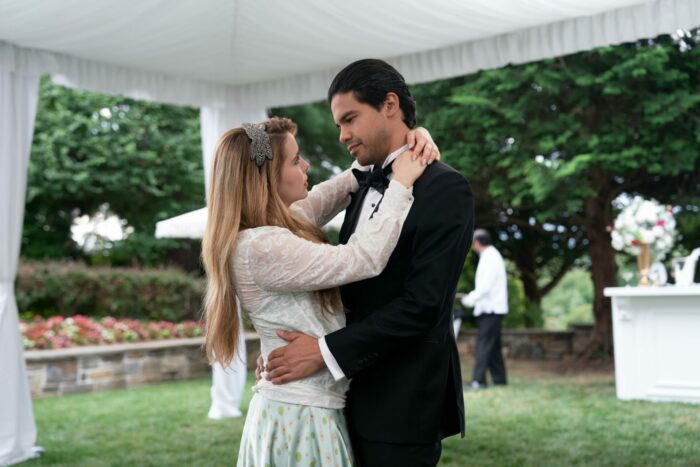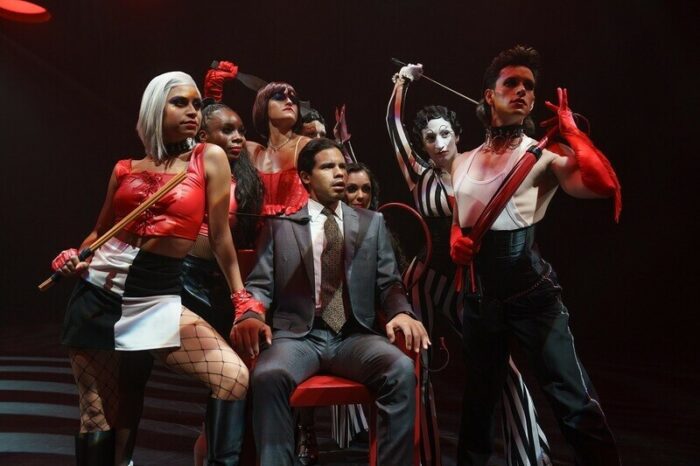Glee premiered like a cherry slushie to the face, jolting networks to the endless potential of what musical television could be. Since 2009, many have attempted to taste that red dye no. 40 glory—some were triumphant like CW’s Crazy Ex-Girlfriend with four seasons of campy original songs and exploration of mental health. Many failed to make it past the two season curse, including NBC’s Smash and Zoey’s Extraordinary Playlist as well as ABC’s medieval musical-comedy Galavant. The latest show taking on the challenge is Hulu’s nostalgic musical rom com Up Here, and it succeeds in story, but misses musically.
Two-thirds Nora Ephron and one-third Broadway musical, the eight episodes of Up Here follow Lindsay (Mae Whitman), an ambitious yet naive aspiring author in New York City, and Miguel (Carlos Valdez), a Columbian video game artist turned investment banker. After an initial awkward hookup, the couple spends the remainder of 1999 in an on/off relationship as they struggle to reveal their truest selves and question if you can really ever know someone.
The main title track “Can I Ever Know You?” switches between asking the optimistic question and answering with “I can never know you.” The characters are mirrors, both struggling with a deep-seated fear of rejection and oppressive gender roles. Miguel wishes he could express his feelings more, and Lindsay wants to feel and care less. Both characters want to know themselves and each other.
Whitman and Valdez play their characters with intense vulnerability and physical chemistry. From their first conversation outside of a bar bathroom to hours later when Miguel cries post-handjob, their connection feels genuine and painfully human. In the moments leading up to their hookup, Lindsay tells Miguel that he doesn’t need to listen to the voices in his head, seeing him in a way that no one else ever has. Lindsay and Miguel are often controlled by the negative, insecure, and scared voices in their subconscious—which are physically manifested by people in their pasts who randomly appear in each episode. Lindsay is visited by a ’70s version of her parents and former childhood-friend warning her about the dangers of discarding her likable, nice girl persona. Miguel listens to the voices of the man who slept with his ex-girlfriend and a teenage tormentor questioning his masculinity, conflicting with his (dead) doting mother.
It’s quite literal to display the character’s inner lives this way, but effective. Understanding the pair’s motivations makes them sympathetic and appeases some of the frustration felt while witnessing their self-destructive behavior. Most of Lindsay’s choices are a result of years spent being repressed by her parents and society. Example being the shame she felt after her friend told her class about Lindsay’s sexual fantasies about a librarian.
She leaves her Ned Flanders-esque fiance and moves to New York to find her voice as a writer, a dream she’s kept on the back burner. In the song “What If,” Lindsay expresses that she is eager to feel understood (“My brain is like a video store // With a big restricted-section door // With lots of cool stuff hiding in the ultraviolet light // What if I let somebody see me tonight?”) In the same tune, her inner-voice-materialized-parents tell her to “clorox offensive thoughts” and “close her knees.” Her hesitation to enter a relationship with Miguel stems from fear of losing her new-found sexual liberation.

Miguel also finds himself pushed into gender roles as his planned proposal is disrupted by finding his girlfriend in bed with another man. He’s torn between the pressure to be masculine and the feeling of never measuring up yet constantly being praised by his mother insisting he’s a “Smart Smart Smart Smart Baby.”
Unlike Lindsay, Miguel is praised for his sexual exploits, especially by his banker co-workers when Miguel takes down the office’s porn firewall. However, Miguel wants a monogamous relationship with Lindsay, and in perhaps the show’s catchiest number, “Falling in Love,” he sings about his desire to fall in love without pain. Miguel’s fear of rejection stems from never feeling like he fit in, partly due to being Latino. In “Tiger Shark,” he sings, “I’m not the bullied brown boy in his all-white school // I’m not the kid who felt too white when he moved to Queens.”
The music is unfortunately where Up Here comes down. With the exception of a few standouts, the songs are fine. But, with Hamiltondirector Thomas Kail, tick, tick…BOOM! screenwriter Steven Levenson, and co-creators Kristen Anderson-Lopez and Robert Lopez of Frozen fame writing the 21 original songs, fine feels like failure.
Occasionally, the show fully leans into the inherent theatricality of the genre and evokes the essence of Crazy Ex-Girlfriend. After accidentally drinking mushroom tea, Miguel is transported into the world of the video game he helped create—singing about “adding armor” to the point where he can longer feel anything (“The Quest.”) Later, Lindsay is a sparkly-suited cabaret singer begging for people to like her (“Please Like Me.”) These songs make sense as drug induced hallucinations.
The fact that Glee takes place in a high school glee club or Smash is about creating a Broadway musical situates the music. In Up Here, it can feel like an afterthought. When the show turns musical numbers like “In So Many Ways,” in a big production featuring costumes and dancers, it makes it clear that this is happening in the character’s head as opposed to reality. Contextualizing the music makes it easier for people to suspend their disbelief, which is necessary when asking the audience to watch characters break out into song on the New York City streets.

The romantic comedy genre is difficult to serialize because it has a natural ending—the couple ends up together. Happily Ever After. The final scene of Up Here Season 1 ending with Lindsay realizing she’s pregnant means that the “falling” is over. Romance can no longer be the central focus. The show can only evolve into a comedy of two people who have already fallen in love, which spoils the genre.
However, a parenting plot line could result in exciting new ways to explore fear and anxiety. Up Here shines with on-screen talent and charm, but it will need more creative ambition if renewed for that Season 2 set up in the finale. It could benefit from playing with the possibilities it has created. Since half of the show takes place in the character’s minds, nothing is off limits. There could be songs happening in the middle of birthing class and further exploration of Miguel’s childhood while his mother was still alive. How will that grief impact him as a father?
Up Here still has plenty of stories left to tell, but in order to live up to its successful musical predecessors, the show needs to embrace the zany and create a soundtrack worthy of a spot on even the most extensive Broadway fan’s playlist.

